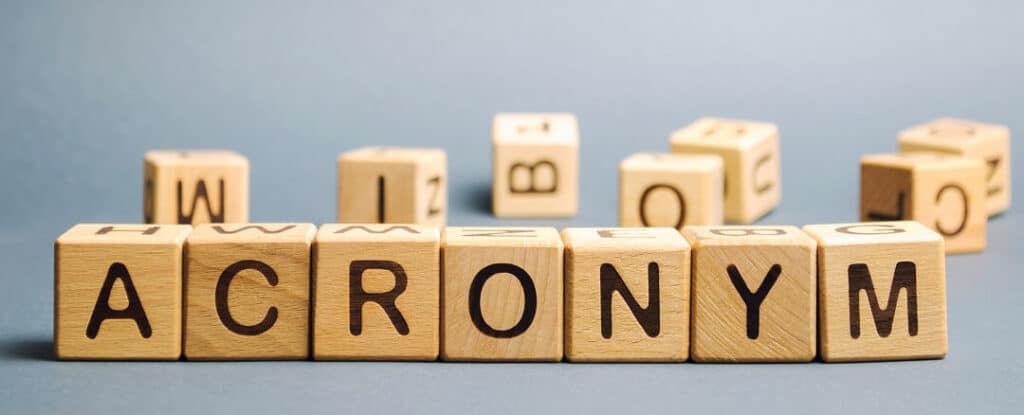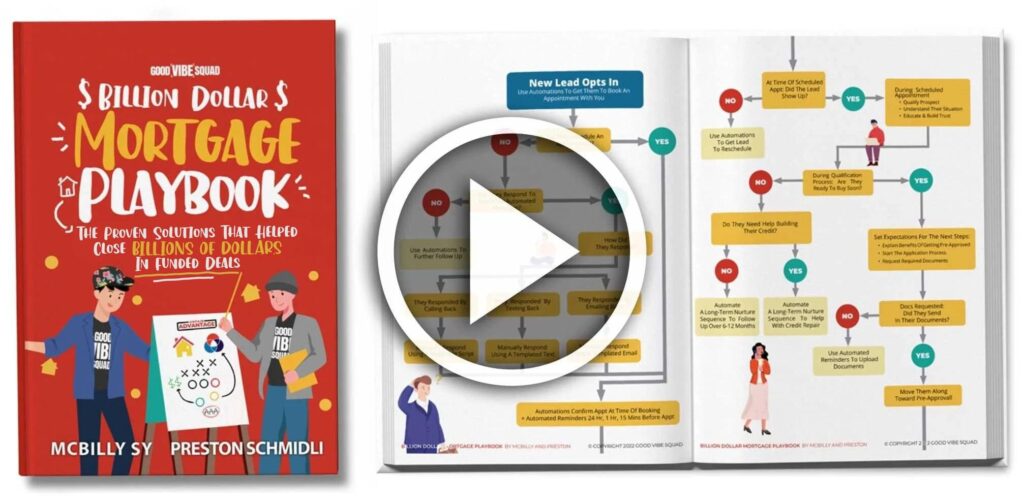Get Our Billion Dollar Mortgage Playbook
Get the proven strategies that helped close Billions of dollars in funded deals!
As a loan officer in the mortgage industry, acronyms are a part of your everyday conversation with coworkers and industry professionals. While it is unlikely that your leads, clients, and even real estate partners will understand all the mortgage lingo, this mortgage acronym cheat sheet is a wonderful resource for not only new loan officers but also for your partners and clients.
24 mortgage acronyms every mortgage professional should know
An acronym is defined as an abbreviation formed from the initial letters of words and often pronounced as a word itself. As a loan officer, you use these acronyms every day, however, you must keep in mind that not everyone understands what these acronyms stand for and really mean. When working with borrowers, especially first-time borrowers, it is important that you use the actual words or explain what a specific acronym means.
Here we offer a comprehensive list and explanation of common acronyms in the mortgage industry.
APR
APR stands for the annual percentage rate. The annual percentage rate is the amount of yearly interest charged on a mortgage loan.
ARM
ARM stands for an adjustable-rate mortgage. With an ARM, the initial interest rate is typically lower, but the interest rate can change multiple times throughout the loan term. These changes are based on market conditions and can increase or decrease.
CD
CD stands for closing disclosure. A closing disclosure provides the loan terms, projected monthly payments, and the closing fees necessary to complete a mortgage.
DTI
DTI stands for debt-to-income ratio. To determine the DTI, you must add together a borrower’s monthly debt, including mortgage payments, and divide that by a borrower’s gross monthly income.ECOA
ECOA stands for the Equal Credit Opportunity Act. This is a federal law that prevents lenders from discriminating against borrowers based on race, color, religion, national origin, sex, marital status, age, or public assistance.
FHA
FHA stands for the Federal Housing Administration. This government agency backs specific mortgages provided through private lenders. FHA-insured loans offer protection to the lender should a borrower default on payments. This protection enables many lenders to offer mortgages to more potential home buyers.
FMV
FMV stands for fair market value. This number is the highest price that a buyer would be willing to pay and the lowest that a seller would be willing to accept on an individual property.
FRM
FRM stands for fixed rate mortgage. This type of mortgage loan has a fixed interest rate for the life of the loan. These loans are often for 15-to-30-year terms.
FICO
FICO stands for Fair Isaac Corporation, an analytics company that generates a three-digit number based on information gathered from a borrower’s credit report. This number helps an underwriter determine how likely a borrower is to repay a loan.
GFE
GFE stands for good faith estimate. This is a form provided by a lender to a borrower when they apply for a reverse mortgage. This form outlines the estimated costs and terms of the proposed reverse mortgage.
HELOC
HELOC stands for a home equity line of credit. This is a line of credit that is borrowed against the equity available in a borrower’s home. This loan allows the borrower to request funds as needed and repay those funds at a set repayment schedule.
HUD
HUD stands for the U.S. Department of Housing and Urban Development. The purpose of HUD is to provide housing and community development assistance and to ensure that everyone has access to fair and equal housing. In addition, HUD oversees the FHA and the Fair Housing Act.
IO
IO stands for an interest-only mortgage. This type of mortgage allows the borrowers to make interest-only mortgage payments for the first few years of the loan, often averaging 5 to 10 years. At the end of the term, the borrower can choose to pay off the loan balance, refinance the mortgage, or begin with loan payments that include an amount towards the principal.
LOX
A LOX, also known as an LOE, stand for letters of explanation. A loan officer or an underwriter may request a LOX from a borrower in order to gain additional information or better explain information that may not be clear to the lender.
LTV
LTV stands for loan to value. This represents the amount of an outstanding loan to the appraised value or sales price. The LTV is given as a percentage number.
MIP
MIP stands for mortgage insurance premium. This is the amount that a borrower pays each month for mortgage insurance. This payment is given to either a government agency, such as FHA, or to a private mortgage insurance company.
P&I
P&I refers to both the principal and interest when it comes to a mortgage payment. This is the portion of your monthly payment that goes toward the interest and principal of the mortgage.
PITI
PITI stands for principal, interest, taxes, and insurance. These components make up a monthly mortgage loan payment.
PMI
PMI stands for private mortgage insurance. This insurance is often required by a lender when a borrower is financing more than 80% of the home value. PMI payments are included in the escrow portion of monthly mortgage payments and this insurance protects the lender from loss should a borrower default on a mortgage loan.
POC
POC stands for costs paid outside of closing. These are fees that are paid outside of the closing, such as appraisal fees, fees for credit reports, etc.
RESPA
RESPA stands for the Real Estate Settlement Procedures Act. This is a consumer protection law requiring mortgage lenders to provide borrowers with advanced notice of closing costs through a Good Faith Estimate.
TILA
TILA stands for the Truth in Lending Act, also known as Regulation Z. This requires a lender to provide borrowers with a disclosure that estimates the total cost of a mortgage loan, including finance charges and the annual percentage rate within three days of the application. This allows borrowers to shop for the best financing option among different lenders.
VA
VA stands for the Department of Veteran’s Affairs. VA loans are specific mortgage loans offered to veterans and are guaranteed by the government. These loans often require little to no down payment.
VOE
VOE stands for the verification of employment. A loan officer or underwriter will request verification of employment to ensure a borrower is able to cover the cost of a down payment and monthly mortgage payments.
Understanding mortgage acronyms for success
Understanding what these acronyms stand for allows you to better educate and explain terminology to your leads, clients, and professional partners. While some of the acronyms are understood outside of the mortgage industry, others are likely to confuse borrowers and require explanation.
Good Vibe Squad helps you gather qualified leads
At Good Vibe Squad, we understand the terminology in the mortgage industry, but we know that all your leads may not. We also understand how important a qualified lead is to successful loan officers. Our Unfair Advantage™ program helps weed out leads that are unlikely to qualify for a mortgage, leaving you with leads that are actively looking for a home and likely to be approved for a mortgage. To learn more about how we can help boost your monthly leads, book a strategy call today.





